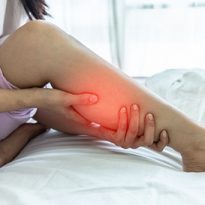
Are you worried about getting a DVT? DVT stands for deep vein thrombosis and occurs when a blood clot forms in the veins of your body. DVT’s occur in the lower legs most often.
Why did I form a DVT?
Blood clots form for various reasons. Not being mobile causes a large incidence of blood clots. When blood moves slowly through your veins it creates a clot. This is why you should always stop and walk during long car rides or airplane trips. Clots can also occur due to injuries/surgeries, being overweight, using birth control or hormone replacement therapy, pregnancy, and having congestive heart failure. If someone in your family has experienced a DVT you are more likely to develop them too. Smoking can also put you at a higher risk.
What are the symptoms of a DVT?
Symptoms include swelling, cramping, warmth, redness, pain, and tenderness in the area that is affected. A DVT can become critical if it moves to the lungs. This is called a pulmonary embolism. If you have any shortness of breath, chest pain, or are coughing up blood, call 911.
How do doctors diagnose a DVT?
If you feel like you have a DVT, call your doctor. Along with a discussion of your symptoms, your doctor may do an ultrasound of your veins, x-ray, or CT/MRI to diagnose and treat the problem.
What’s the treatment for a DVT?
Your doctor will want to restrict the clot from moving around your body. Your doctor may order an anticoagulant, also known as a blood thinner. An anticoagulant will prevent the clot from getting bigger and more clots from forming. Anticoagulants come in injection and pill form. Your doctor may also use a filter to keep the clot from traveling to the lungs or, in some cases, surgery to remove the clot.
How do I prevent DVTs?
Staying active, avoiding long periods of sitting, exercising regularly, and maintaining a healthy weight are the best ways to prevent blood clots from forming. If you undergo a surgical procedure, your doctor might start you on a blood thinner to reduce your risk of DVT. Compression stockings are also often times suggested following surgery to keep blood flowing properly.
